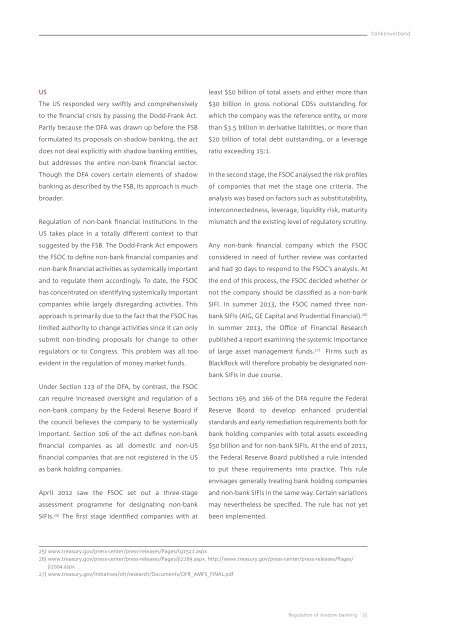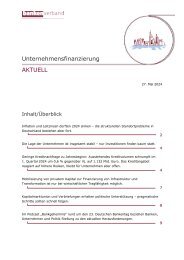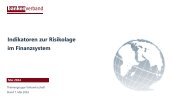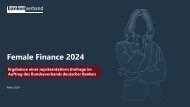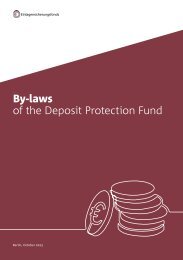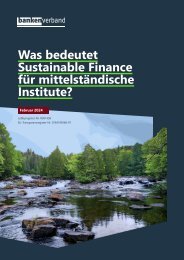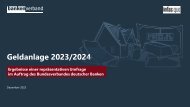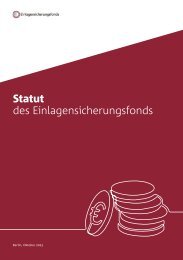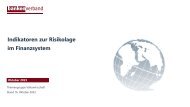Regulation of shadow banking
Shadow banking is given a large share of the blame for the financial crisis. This perception raises the question of what kind of shadow banking system should remain in place in the future.
Shadow banking is given a large share of the blame for the financial crisis. This perception raises the question of what kind of shadow banking system should remain in place in the future.
Create successful ePaper yourself
Turn your PDF publications into a flip-book with our unique Google optimized e-Paper software.
ankenverband<br />
US<br />
The US responded very swiftly and comprehensively<br />
to the financial crisis by passing the Dodd-Frank Act.<br />
Partly because the DFA was drawn up before the FSB<br />
formulated its proposals on <strong>shadow</strong> <strong>banking</strong>, the act<br />
does not deal explicitly with <strong>shadow</strong> <strong>banking</strong> entities,<br />
but addresses the entire non-bank financial sector.<br />
Though the DFA covers certain elements <strong>of</strong> <strong>shadow</strong><br />
<strong>banking</strong> as described by the FSB, its approach is much<br />
broader.<br />
<strong>Regulation</strong> <strong>of</strong> non-bank financial institutions in the<br />
US takes place in a totally different context to that<br />
suggested by the FSB. The Dodd-Frank Act empowers<br />
the FSOC to define non-bank financial companies and<br />
non-bank financial activities as systemically important<br />
and to regulate them accordingly. To date, the FSOC<br />
has concentrated on identifying systemically important<br />
companies while largely disregarding activities. This<br />
approach is primarily due to the fact that the FSOC has<br />
limited authority to change activities since it can only<br />
submit non-binding proposals for change to other<br />
regulators or to Congress. This problem was all too<br />
evident in the regulation <strong>of</strong> money market funds.<br />
Under Section 113 <strong>of</strong> the DFA, by contrast, the FSOC<br />
can require increased oversight and regulation <strong>of</strong> a<br />
non-bank company by the Federal Reserve Board if<br />
the council believes the company to be systemically<br />
important. Section 106 <strong>of</strong> the act defines non-bank<br />
financial companies as all domestic and non-US<br />
financial companies that are not registered in the US<br />
as bank holding companies.<br />
April 2012 saw the FSOC set out a three-stage<br />
assessment programme for designating non-bank<br />
SIFIs. 25) The first stage identified companies with at<br />
least $50 billion <strong>of</strong> total assets and either more than<br />
$30 billion in gross notional CDSs outstanding for<br />
which the company was the reference entity, or more<br />
than $3.5 billion in derivative liabilities, or more than<br />
$20 billion <strong>of</strong> total debt outstanding, or a leverage<br />
ratio exceeding 15:1.<br />
In the second stage, the FSOC analysed the risk pr<strong>of</strong>iles<br />
<strong>of</strong> companies that met the stage one criteria. The<br />
analysis was based on factors such as substitutability,<br />
interconnectedness, leverage, liquidity risk, maturity<br />
mismatch and the existing level <strong>of</strong> regulatory scrutiny.<br />
Any non-bank financial company which the FSOC<br />
considered in need <strong>of</strong> further review was contacted<br />
and had 30 days to respond to the FSOC’s analysis. At<br />
the end <strong>of</strong> this process, the FSOC decided whether or<br />
not the company should be classified as a non-bank<br />
SIFI. In summer 2013, the FSOC named three nonbank<br />
SIFIs (AIG, GE Capital and Prudential Financial). 26)<br />
In summer 2013, the Office <strong>of</strong> Financial Research<br />
published a report examining the systemic importance<br />
<strong>of</strong> large asset management funds. 27) Firms such as<br />
BlackRock will therefore probably be designated nonbank<br />
SIFIs in due course.<br />
Sections 165 and 166 <strong>of</strong> the DFA require the Federal<br />
Reserve Board to develop enhanced prudential<br />
standards and early remediation requirements both for<br />
bank holding companies with total assets exceeding<br />
$50 billion and for non-bank SIFIs. At the end <strong>of</strong> 2011,<br />
the Federal Reserve Board published a rule intended<br />
to put these requirements into practice. This rule<br />
envisages generally treating bank holding companies<br />
and non-bank SIFIs in the same way. Certain variations<br />
may nevertheless be specified. The rule has not yet<br />
been implemented.<br />
25) www.treasury.gov/press-center/press-releases/Pages/tg1521.aspx<br />
26) www.treasury.gov/press-center/press-releases/Pages/jl2169.aspx. http://www.treasury.gov/press-center/press-releases/Pages/<br />
jl2004.aspx<br />
27) www.treasury.gov/initiatives/<strong>of</strong>r/research/Documents/OFR_AMFS_FINAL.pdf<br />
<strong>Regulation</strong> <strong>of</strong> <strong>shadow</strong> <strong>banking</strong> 25


